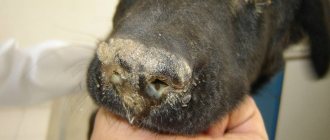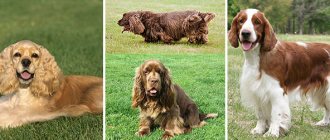All four-legged pets are guided by wolf instincts. Unquestioning submission to a person is possible only on the part of some breeds that are alien to aggression - due to constant close contact.
Despite this feature, even they can periodically show leadership habits and rebel against the established order in the house. If you are faced with such a problem, then below you can find out how to properly dominate a dog and become a leader for it.
The importance of hierarchical relationships in a family with four-legged animals
A dog's obedience depends on its position in the hierarchy. The following ranks exist in wolf and wild dog packs:
- alpha – leader and dominant female, responsible for making all important decisions and protecting other animals;
- beta – substituents of the first group;
- gamma - young animals without a pair, responsible for protecting the territory and having the right to create their own pack;
- omega - puppies and older four-legged animals with a minimum number of rights.
The tasks of the leader do not include raising offspring and daily patrol. He serves as a provider and protector. He always gets the first piece of food, and his decisions are considered undeniable.
The change of leader occurs through a fair one-on-one fight. Any rebellion against the rules is harshly extinguished by the pack.
Our pets are guided by similar instincts. The main rebels are the grown-up youngsters, that is, representatives of the gamma rank. To avoid dominant behavior and disobedience on the part of the pet, the owner must prove his leadership.
IMPORTANT!
If you live not alone, but with children or other family members, then their place in the hierarchy should be higher than that of the dog.
When and how does a dog begin to dominate its owner?
The first attempts at dominance occur with the advent of puberty, when puppies test the boundaries of what is permitted. Such a test of strength makes it possible to establish dominant roles, and the alpha rank does not always remain with a person.
You should not give in to an adult animal if it has only recently become part of your family. Unconditional acceptance of the leader in the person of the owner is characteristic only of some breeds: hunting and companion breeds. Both of them were bred to serve humans, so aggressive behavior and other signs of disobedience are not characteristic of them.
Dominant behavior can be recognized by the following signs:
- Encouragement to fulfill one's own whims
. Touching with a paw and persistently offering a brought toy may seem cute, but this is where the probing of weak spots begins. If the dog understands that his barking is followed by what he wants, then he will continue to dictate to you what to do.
- Assault on territory
. The pet must have its own place. Sleeping on a bed or sofa is possible, but only after obtaining appropriate permission. Silent consent to the attack on your favorite chair and the absence of prohibitions are unacceptable here.
- Disregard for the owner's opinion
. The leader must manage relations with other members of society. Attacking friendly passers-by and ignoring stop commands is an open challenge in your direction.
- Food aggression
. Here again we should remember the wolves. Members of the pack eat only when the leader allows them to. If the dog grins at attempts to take away its bowl or toy, sound the alarm.
- Ignoring commands
. This reaction is normal for constantly distracted puppies, but only in isolated cases. Regular disobedience is an attempt at sabotage with the aim of changing power.
- Aggression towards the owner. This is the most dangerous sign, accompanied not only by a growl, but also by a direct attack. Its main reason is prolonged ignoring of the above-mentioned signs.
Do not confuse attempts at dominance with ordinary expressions of love. Gently poking with a wet nose and a pitiful look in order to attract attention for play are completely harmless, but outright provocations in the form of howling and jumping on your head are a cause for concern.
“All of the above cannot be ignored. Lack of punishment can aggravate the existing problem and lead to a complete loss of the dominant role in the home.
OKD and ZKS training courses did not solve the problem of domestic aggression
Our ward, the German shepherd Patra, not only completed dog sports training courses at the training site - OKD (general training course) and ZKS (protective guard service course), but also received good marks when passing the exams.
Tatyana regularly received invitations to regional events organized by the local DOSAAF club and Patra never failed, demonstrating very spectacularly the skills she had developed.
And in the near future, she again had to take part in competitions, where, of course, everyone expected her to enthusiastically pursue a defendant dressed in a dress suit, gracefully jump, grab and neutralize a conditional opponent.
But, OKD and ZKS were powerless in stopping the dog’s domestic aggression.
Causes of dominant dog behavior
Existing reasons can be divided into 2 groups. The first includes mistakes made in upbringing, and the second includes innate and acquired instincts.
Parenting mistakes
An animal's behavior is determined not only by genes, but also by its environment. Timely socialization and training help to avoid aggression and other unwanted actions. Despite the importance of upbringing, many owners neglect it due to laziness, lack of time and a simple lack of understanding of the possible consequences.
Most often, the problem develops against the background of permissiveness and lack of attention. In both situations, the animal is given the right to make independent decisions, which is unacceptable when building hierarchical relationships.
Natural data
Another possible reason is instincts. The most problematic animals include the following four-legged animals:
- large guard and fighting breeds;
- animals from the street who lived in a dog pack;
- native breeds from the group of huskies, basenjis, etc.;
- dogs with a developed territorial instinct.
Such pets are united by a pronounced tendency to dominate, which can only be suppressed by a strong and experienced dog breeder. They do not obey children, as weaker family members, and constantly strive to seize power in the house.
Dominant behavior in females and males
The main signs of dominant behavior were described above. They are typical for both sexes, but with one caveat.
The main rebels are males, so their attempts are always more arrogant and pronounced. In addition to the above, one should add here indiscriminate landings on human legs and arms.
IMPORTANT!
Cages for the purpose of dominance are characterized by a lack of arousal. This helps to distinguish them from those associated with the sexual instinct.
Bitches act more carefully. They test the waters for a long time, determining the boundaries of what is permitted. Their first attempts at dominance are always aimed at the weakest members of the family: children and small pets. Aggression towards older owners develops increasingly. This distinguishes them from reckless males who can start a riot without preparation.
How to become a leader for a dog and show that you are in charge
Dealing with the results of improper upbringing is always more difficult and takes longer, so dog experts recommend not delaying training and doing it from the first days your pet appears in your home. To do this, you need to understand how to show the dog who is the boss and leader in the family. Existing methods depend on the age of the four-legged animal.
Working with a puppy
Before puberty, babies unconditionally listen to their owners, so training during this period gives the best results. It includes the following points:
- Place training
. Any attempts to sit on the furniture without your permission should be prevented. To avoid rioting, find a comfortable and safe corner for your pet in advance. The puppy's bed should be placed on the floor, since all high surfaces should belong to the leader.
- Stopping stacking from above
. Sleeping on your arms and back looks cute, but it also serves as a sign of dominance. This position is only permissible with your permission when you are placing the puppy on you. If he tries to climb on his own, carefully grab him by the withers and lower him to the floor, turning him onto his back, that is, into a submission position.
- Getting used to feeding after a person
. Don't forget that in a pack the leader eats first. Feed your four-legged dog strictly after finishing its own meal. This is important for building the correct hierarchy and preventing begging.
- Stopping Leash Pulling
. The right to lead belongs strictly to the leader, so never walk behind your pet. If he rushes forward and pulls on the leash, silently turn in the opposite direction and start moving. A sudden change in trajectory will confuse the puppy and force it to act instinctively - to follow the leader.
- Fighting possessive aggression
. Hand feed your puppy, add food to his bowl as he feeds, and pick up his toys periodically. If he grins and growls, be sure to punish him. Temporary isolation in an enclosure is suitable for this. Negative reinforcement will allow the baby to learn that the owner needs to obey.
Love, but never put the puppy above everything else. Constant babying and lack of punishment form in his head the realization that he is the head of the family.
Working with an adult animal
Most often, owners ask dog handlers how to subdue an adult dog, because this is much more difficult. The same recommendations apply here, but with a small addition.
Animals taken from the shelter and the street are either used to defending themselves on their own, or have been subordinate to another alpha male for a long time. They need more time to adapt and get used to their new family.
Case Study
I would like to describe one case from my practice (there were a lot of such cases, but this one is the most indicative).
A future instructor studied in my training unit - a guy of short stature, thin, but with a strong and even tough character. Serving with him was a male German Shepherd of zone-gray color, powerful and just as serious. This was the soldier's personal dog, which he raised at home. And just during the training course, the male began to try to gain the upper hand in the relationship with his owner.
Once every three or four days they literally fought, this happened while practicing obedience skills. Naturally, when the male grabbed the guy by the hand and looked into his eyes with a growl, he retreated (the hands were not official). There is an urgent need to do something. At that time, for some reason, our superiors treated the facts of beating dogs with hysterical indignation; those caught in this crime were severely punished, and their commanders also received punishment.
That's why we acted underground. The guy put a muzzle on the dog and went further into the forest. Strictly following my instructions, he stupidly gave only three commands: sit, lie down, stand, while tugging the leash quite strongly. Naturally, the male attacked him in the first minute. Here the cadet came in handy with a previously prepared improvised leather whip and a lovingly sawed wood. Using the tools, the cadet achieved the command every time. The male stopped attacking him only AFTER TWO HOURS of “lesson”!!!
It took another hour to work without a muzzle (now the cadet put on a winter army jacket, despite the summer heat, and reinforced the sleeves with branches).
The dog didn’t eat for two days (it’s not easy to change the rating), but until the end of the course this male was controllable without a leash and almost made it into the sports training team. At the same time, no signs of “resentment” were observed. The male faithfully rejoiced at the arrival of his owner, whined when parting, etc.
That is, being in the pack system, the dog does not even think about “breaking off relations” or “being offended”; it is also loyal and happy from communicating with the owner. The only question is who will be the leader?
Hard case
Four-legged animals recognize their owners as leaders because they feed them and protect them. All other recommendations serve to suppress overly dominant individuals.
In most cases, the problem can be solved on your own, but there are exceptions. If you do not see any results for a long time, and your pet begins to show open aggression towards family members, do not take risks and seek help.
Appeal to the dog handler
The animal can be raised under the guidance of a dog handler without your participation, but this method prevents the establishment of a strong connection with the owner.
The best option is individual lessons, where there is no chance of distraction by other participants. After the introductory lesson, they will point out the weak points in your pair and help you deal with them. It will not be superfluous to take obedience courses: UGS and OKD.
Castration of an animal
Dominant aggression can also be eliminated through castration. If you do not plan to participate in breeding, sign up your pet for surgery. It promotes calmer behavior and protects against cancer of the reproductive organs.
Obedience course
The first thing you need to do is start obedience training. It sounds corny, but without training you won't achieve anything. Practicing exercises of almost any course effectively reduces the dog’s level of dominance, since many of these exercises involve establishing control over the animal. By practicing moving nearby, sitting, laying down, standing, you dictate to the dog the position of its body. By practicing shutter speeds, you establish time control. After all, working on any command means doing your will and obeying you.
Dogs with developed dominant aggression attack their owners precisely when practicing simple obedience skills. And forcing the dog to still carry out the command is the most effective “cure” against dominance.
Fighting dominant aggression
It has already been said above that aggression is an extreme degree of dominant behavior. Dealing with periodic jumping on the bed and sofa is much easier than working with an animal that is not afraid to attack the one who feeds it.
Block disgruntled growling and attack attempts with distraction or ignoring. If the pet is already sabotaging the execution of commands, then loud sounds are suitable for distraction: clapping hands, the squeak of a toy, or the fall of a heavy object.
Ignoring is a demonstration of one’s superiority, because a true leader is confident in his own strength and will not stoop to showdowns with representatives of lower ranks. It is important to understand here that this method only works when simulating an attack, and not when actually using fangs and claws. In the latter case, it is better to seek help.
By its behavior, your pet indicates your poor leadership qualities.
Irritation and empty screaming will only strengthen righteousness in the animal’s mind.
During a walk, the dominant dog will run ahead of the owner and pull hard on the leash. Walking alongside means recognizing you as a leader.
During the game, the animal sets the rules. If you try to do it your way, the pet will burst into barking or growling in displeasure.
Dogs are often respectful of adults, but children are treated as equals or at a lower level. They behave unrestrainedly with children, are irritable, bare their teeth and bite. This is especially true when parents yell at them in the presence of an animal.











